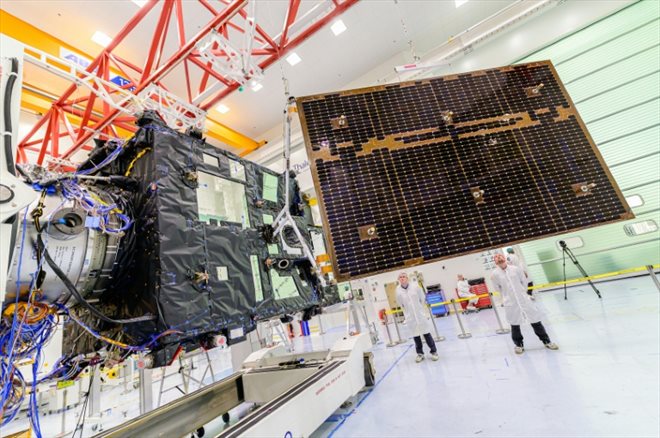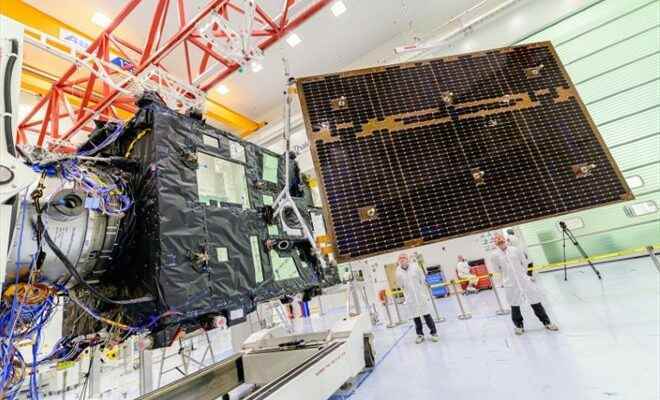Photo released by Thales Alenia Space on September 9, 2022 of the MTG-I1, a third generation weather satellite, in Cannes (Thales Alenia Space/AFP/Handout)
Twelve years of preparation and several billion euros to scrounge up a few precious hours in predicting severe weather phenomena: Europe is preparing to launch the first of its new generation weather satellites.
Wrapped in a black insulating film enamelled with mirrored surfaces to reflect the heat of the sun, the 3.8-ton beast sits in the Thales Alenia Space clean room in Cannes before taking the boat to Kourou, from where it must be. launched by the end of the year.
Once in orbit at an altitude of 36,000 kilometers, MTG-I1, for Meteosat’s third-generation imager, will scan the planet every 10 minutes with an accuracy of up to 500 meters, half as much as the previous generation launched at from the early 2000s.
It should be followed by 2025 by a twin (MTG-I2), which will focus on Europe at the rate of a scan every two and a half minutes, and a satellite equipped with a probe ( MTG-S) which will analyze the composition of the atmosphere over its entire height.
Three other similar satellites, already under construction, should succeed them at the end of their lifespan, of at least eight and a half years.
In total, this program launched in 2010 represents a budget of 4.3 billion euros, shared between ESA and Eumetsat, the organization responsible for operating these satellites for 20 years.
A massive investment justified by the fact that no weather report is possible today without these space sentinels.
“More than 95% of the 40 million observations made each day for weather forecasts come from satellites,” said Simonetta Cheli, director of Earth observation programs at the European Space Agency (ESA).
And “with the exponential growth of extreme weather events”, she recalls, the images must be more and more precise and frequent. The challenge: to detect the rapid evolution of convective phenomena, these movements of the atmosphere at the origin of thunderstorms and storms.
The thunderstorms accompanied by gusts of more than 200 km/h which hit Corsica on August 18, killing five, come from a rapid accumulation of water vapor in the atmosphere on a very localized surface, and “this type local change can be detected very quickly by MTG,” says Donny Aminou, Satellite Payload Manager for ESA.
– A “wink from 10 kilometers” –
“We have a lot of expectations on monitoring the development of convective clouds, we hope to gain a few hours of notice”, crucial for alerting populations, abounds Hervé Roquet, deputy director of research at Météo France.

Photo released by Thales Alenia Space on September 9, 2022 of the MTG-I1, a third generation weather satellite, in Cannes (Thales Alenia Space/AFP/Handout)
The satellite carries another valuable instrument in the eyes of meteorologists: a lightning detector, a first in Europe.
Equipped with four cameras, it can “distinguish the equivalent of the blink of an eye at 10 kilometers” day and night, according to Carlo Simoncelli, program manager at Italian Leonardo.
Some of the lightning is currently detected by terrestrial systems, but those that streak the clouds without touching the ground are much more numerous and were not. However, these can be precursors of devastating storms, according to Mr. Roquet, who also underlines a breakthrough for aviation safety.
MTG’s sensors will also better detect forest fires and particles in the atmosphere. The closure of air traffic such as that which occurred over a large region due to the ash scattered by the eruption of an Icelandic volcano in 2010 could thus be avoided from now on, according to its designers.
“Now, meteorologists only have to digest the data,” laughs Pierre Armand, program manager for Thales Alenia Space, the industrial prime contractor.
The volume of data sent to Earth promises to be colossal: 110 megabits per second (Mbps) every day, 50 times more than the previous generation. They will also be used to develop new weather forecasting and climate change models.
At the same time, Europe is preparing the next generation of Metop satellites. These two weather satellites in low orbit, at a few hundred kilometers altitude, are complementary to geostationary satellites such as MTG.
Used for 10-day forecasts, Metops take higher quality images of the entire surface of the Earth but only pass over the same area on a daily basis.
In 2025, the whole panoply of European meteorological satellites will have been renewed.
© 2022 AFP
Did you like this article ? Share it with your friends with the buttons below.




